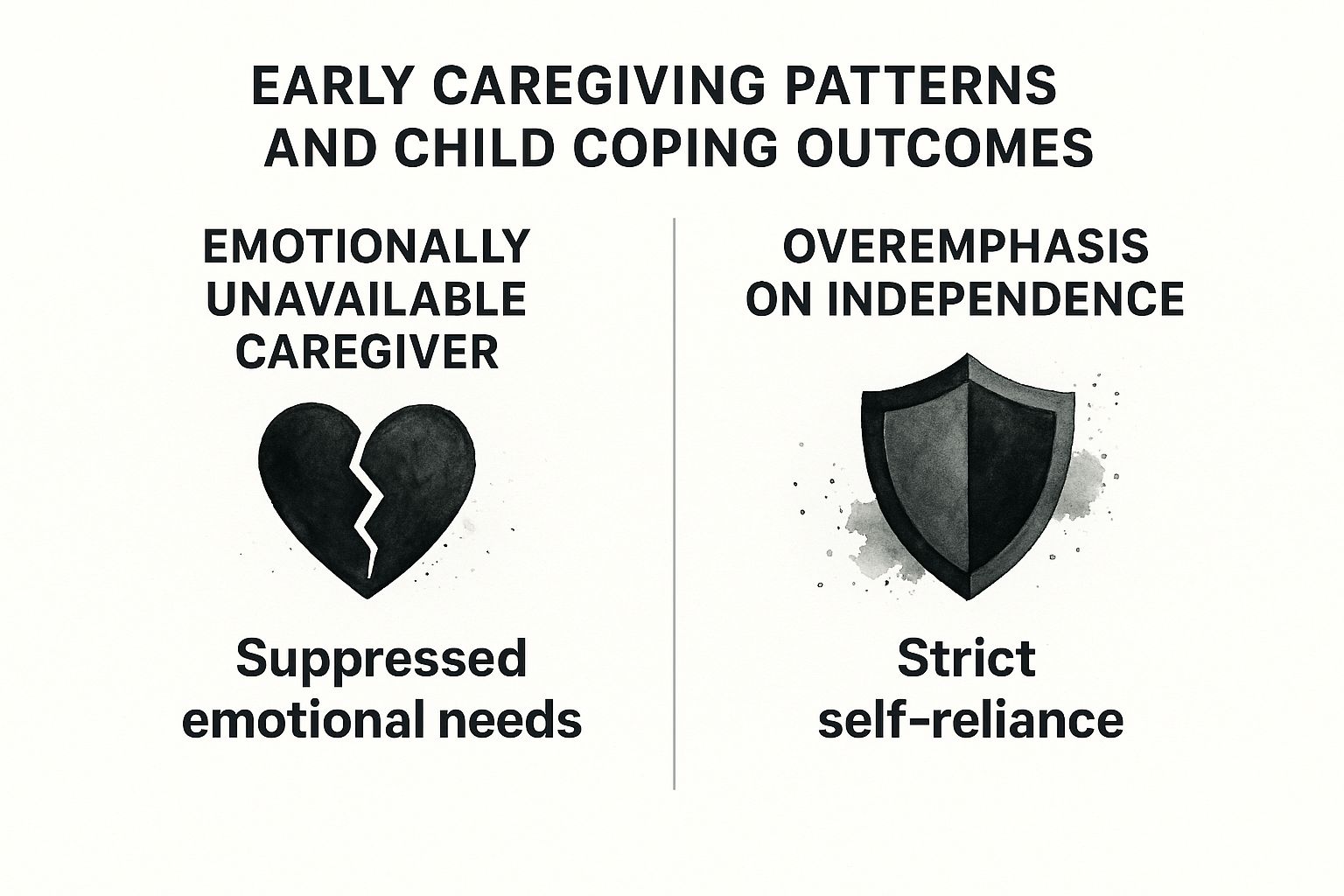A dismissive attachment style is a way of relating to others where independence and self-reliance are prized above almost everything else, especially emotional closeness. It often takes root in our earliest experiences, shaping adults who see themselves as strong and capable but might view others as needy or unreliable.
The Self-Sufficient Fortress Explained

Picture someone living inside a well-built, self-sufficient fortress. Within these walls, they feel safe, in control, and completely independent. They learned early on that relying on themselves was the only sure way to sidestep disappointment and pain.
This fortress has towering walls and a heavily guarded gate, making it tough for anyone to get too close. While the person inside is proud of their strength, this emotional distance isn't some character flaw—it’s a survival strategy they learned long ago.
Core Beliefs and Behaviors
This entire pattern is built on a few core beliefs that drive how they act in relationships. People with this style often feel that emotional closeness is suffocating, or at the very least, unnecessary. They might truly believe that asking for help is a sign of weakness and that real strength means handling everything on your own.
This mindset naturally leads to certain behaviors:
- Prioritizing Independence: They fiercely protect their autonomy and personal space. It's non-negotiable.
- Avoiding Emotional Intimacy: Deep, vulnerable conversations or big displays of emotion can feel intensely uncomfortable.
- Downplaying Emotions: They tend to rationalize or suppress what they’re feeling, often seeing emotions as illogical or unproductive distractions.
- Viewing Others Critically: It's common for them to see partners who express emotional needs as "clingy" or overly demanding.
The dismissive attachment style is, at its heart, a defense mechanism. It’s a way of thinking, "I don't need anyone, so no one can hurt me." This mindset works wonders at protecting them from potential rejection, but it also keeps genuine connection at arm's length.
Ultimately, to understand the dismissive attachment style, you have to see it as a shield. It's a shield that was forged in early environments where emotional needs simply weren't met. It’s not about a lack of caring, but a deeply ingrained belief that self-reliance is the only path you can truly count on. This is the foundation, and it's a crucial piece of the puzzle whether you see these traits in yourself or in someone you love.
Understanding the Roots of Dismissive Attachment
A dismissive attachment style doesn't just pop up out of nowhere; it's a direct result of a person's earliest experiences in childhood. Think of a child like a tiny plant. For that plant to grow up feeling strong and secure, it needs a steady supply of emotional sunlight and water. When those things are in short supply, the plant adapts. It learns to get by with less, becoming incredibly self-sufficient but not very open.
This pattern often takes root when a child's caregivers are consistently emotionally unavailable. When a child reaches out for comfort—maybe after a scraped knee or a bad dream—and gets met with dismissal or irritation, a powerful message is sent. They start to learn that showing their vulnerability only leads to being let down. To avoid that sting, the child begins to push down their emotional needs. This isn't a conscious decision; it's a brilliant, subconscious survival strategy.
The Push for Premature Independence
In a similar vein, some childhood environments put a huge emphasis on independence way too early. Now, teaching self-sufficiency is a good thing, but pushing a child to be completely independent before they're ready can teach them that needing other people is a sign of weakness. They start to connect being competent with being alone, internalizing the idea that they have to handle everything by themselves.
At its core, the dismissive attachment style is a learned adaptation. The child basically concludes, "My emotional needs won't be met by others, so I will stop having them. I can only rely on myself."
This infographic breaks down how these two common caregiving patterns can lead to different outcomes.

As you can see, different parenting styles can steer a child down a path of either emotional suppression or rigid self-reliance just to cope. Grasping what makes someone emotionally unavailable is a huge piece of understanding how this whole dynamic works.
Cultural and Environmental Influences
It's not just about the immediate family, either. Broader cultural values can also have a major hand in shaping how we attach to others. The norms and expectations around parenting in a particular culture can either encourage or discourage the development of a dismissive style.
For example, studies have shown some pretty big differences across cultures. In Northern Germany, where independence is prized from a very young age, a whopping 52% of infants were found to have an avoidant attachment pattern—the precursor to an adult dismissive style. Compare that to Japan, where close mother-infant bonding is the norm, and zero infants were classified as avoidantly attached. These findings really drive home how much local parenting philosophies and socioeconomic factors can shape us from the very beginning.
Recognizing the Signs of a Dismissive Attachment Style

Spotting a dismissive attachment style in the wild isn't always easy. In fact, many of its core traits—like fierce independence and radical self-reliance—are often celebrated in our culture. But when these strengths are dialed up to the extreme, they can become a fortress, keeping true intimacy at bay.
The most telling sign is an almost non-negotiable need for personal freedom and space. Someone with a dismissive attachment style often feels suffocated by too much closeness or a partner's emotional demands. This isn't a malicious attempt to push people away; it's a deeply ingrained defense mechanism designed to maintain a sense of safety and control.
And it's more common than you might think. Research suggests that roughly 18-25% of adults fall into the dismissive attachment category, a significant slice of the population. The pattern is defined by a powerful sense of self-sufficiency paired with a tendency to downplay the importance of close relationships. You can explore more of these attachment style statistics on droracle.ai.
Internal Thoughts vs. External Actions
To really get what's going on, you have to look at the massive gap between what a person with a dismissive attachment style is thinking and how they're actually behaving. Internally, their world feels logical, rational, and self-protective. Externally, their actions can come across as distant, cold, or just plain uncaring.
The core conflict for the dismissive attachment style is the disconnect between their internal logic, which prioritizes self-preservation, and the external perception of their behavior, which often reads as emotional withdrawal or indifference.
This disconnect is the root of so many relationship challenges. The table below paints a clearer picture of this contrast, showing how private thoughts can lead to public actions that often confuse a partner.
Dismissive Attachment Style Internal Experience vs External Behavior
| Situation | Internal Experience (Thought/Feeling) | External Behavior (Action) |
|---|---|---|
| Partner is Upset | "This is overwhelming. I need to fix this logically, not get tangled in the emotion." | Offers solutions instead of comfort; may seem cold or detached. |
| Discussing the Future | "I'm not sure I want to be tied down. My independence is too important to risk." | Avoids making long-term commitments or uses vague language. |
| Receiving a Compliment | "That's nice, but I don't need validation. My self-worth comes from my own achievements." | Downplays the praise or quickly changes the subject. |
| Conflict Arises | "This is pointless drama. I'm just going to give them space until it blows over." | Physically leaves the room or emotionally shuts down ("stonewalling"). |
Seeing these patterns laid out makes it easier to understand how intentions and impact can be so different. Recognizing this dynamic is the first step, whether you're seeing it in yourself or trying to better understand someone in your life.
How Dismissive Attachment Affects Relationships
In a relationship, a dismissive attachment style often feels like an invisible wall, creating a subtle but persistent distance that can leave partners and friends feeling confused and shut out. Since people with this style prize independence above all else, they often struggle to meet the emotional needs of others. This isn't out of malice, but from a deep-seated discomfort with vulnerability.
This dynamic can be especially challenging in a romantic partnership. The partner of someone with a dismissive attachment style might feel like they're always the one pushing for emotional conversations or trying to deepen the connection.
They might express a need for closeness only to be met with logic, problem-solving, or a sudden need for personal space. Over time, this can make them feel unimportant, as if their feelings are an inconvenience to be managed rather than shared.
Deactivating Strategies in Conflict
When conflicts heat up, people with a dismissive attachment style often fall back on what experts call deactivating strategies. These are mental and behavioral tactics used to suppress attachment-related thoughts and feelings, all in an effort to maintain distance and a sense of control.
Think of them as emotional escape hatches. Common examples include:
- Emotional Withdrawal: Instead of engaging with a partner's feelings, they might shut down completely, go silent, or even physically leave the room.
- Minimizing the Problem: They might downplay the importance of a conflict by saying things like, "You're overreacting," to sidestep any emotional messiness.
- Focusing on Flaws: To justify their emotional distance, they may mentally catalog their partner's imperfections, which reinforces their core belief that self-reliance is simply safer.
This pattern of withdrawal isn't meant to punish; it's a protective reflex. The individual is retreating to their 'fortress' where they feel safe and self-sufficient, effectively shutting down the emotional systems that feel threatening.
Friendships and Professional Connections
The influence of this attachment style doesn't stop with romance. Friendships can feel pleasant but often remain superficial, as the person avoids the deeper, more vulnerable sharing that builds true intimacy.
At work, they might be superstars on independent tasks but struggle with collaborative projects that require emotional give-and-take and teamwork.
This discomfort with closeness has a real, measurable impact on relationship stability. Research has shown that a dismissive attachment style statistically lowers the odds of maintaining a close, stable relationship. One study found that this discomfort can reduce the likelihood of having a close partnership by about 5%.
The findings point to a clear link between this style and relationship instability, which helps explain why these connections can feel so difficult to sustain. You can explore the full findings on attachment and well-being here. Understanding these dynamics is the first step toward building empathy and finding healthier ways to connect.
Practical Steps Toward Secure Attachment

Shifting away from a dismissive attachment style isn’t about flipping a switch overnight. Think of it as a journey of self-discovery, not a race to a finish line. The goal isn’t to erase your independence but to build emotional flexibility—something that might feel foreign right now.
It all starts with a little self-compassion. You have to recognize that this pattern of yours was a protective strategy, a suit of armor that probably served you really well in the past. Now, it's just about learning when you can take it off.
The first step is simply to notice. Your gut instinct might be to rationalize or dismiss feelings as soon as they pop up. Instead of shoving them away, just get curious for a moment. Mindfulness can be a game-changer here.
When you feel that old, familiar urge to pull away or shut down, just pause. Ask yourself, "What am I actually feeling right now?" You don't have to fix it or act on it. Just naming the emotion is a huge win.
Building Emotional Awareness
Learning to understand your emotions is a bit like learning a new language. Your native tongue might be logic and action, but becoming fluent in "emotion" opens up a whole new world of connection.
Here are a couple of ways to practice:
- Journal your feelings: Get it all down on paper without judging yourself. This creates a safe, private space to figure out what’s going on inside before you even think about sharing it with someone else.
- Use a feelings wheel: This simple tool can help you get more specific. Instead of just "mad" or "sad," you can pinpoint feelings like "frustrated," "lonely," or "disappointed."
This process is really about building a better relationship with yourself first. A genuine connection with others only becomes possible when you can connect with your own inner world without seeing it as a weakness.
Practicing Vulnerability Safely
I get it—the very idea of vulnerability can feel terrifying if you've spent a lifetime being the self-reliant one. The key is to start small. Really small. Think low-stakes interactions. You don't have to spill your deepest secrets on day one.
Instead, just try expressing a minor preference or a simple feeling. For example, instead of the default, "I don't care where we eat," try saying, "I'm actually in the mood for Italian tonight."
That small act of stating a personal need directly challenges the core belief that you have to be 100% self-sufficient. For anyone looking to go deeper, you can learn more about how to develop a secure attachment style in our detailed guide.
These little steps build on each other, slowly teaching your nervous system that it’s actually safe to lean on others sometimes. And that’s where healthier, more fulfilling relationships begin.
Connecting with a Dismissive Partner
Loving someone with a dismissive attachment style can often feel like a lonely road, but building a real, meaningful connection is far from impossible. The trick isn't to try and "fix" them but to understand their world and learn how to communicate effectively within it. You have to remember that their fierce independence is a deeply rooted defense mechanism, not a personal rejection of you.
When your partner pulls away, our natural instinct is often to chase after them, to push for more closeness. But this can backfire, triggering their need for space even more. Instead, try offering them room to breathe without making them feel guilty about it. Their retreat is about managing their own internal overwhelm; it's rarely about their feelings for you.
Fostering Connection Without Pressure
Patience is your single greatest asset here. Building trust takes time, especially with someone who learned very early in life that self-reliance was the safest way to exist. Focus on creating shared experiences that build a bond without demanding intense emotional vulnerability right out of the gate.
Here are a few constructive strategies you can try:
- Use ‘I’ Statements: Frame your needs from your own perspective. Instead of saying, "You never open up," try something like, "I feel more connected when we share parts of our day." This approach feels less like an accusation and is much more likely to be heard.
- Plan Shared Activities: Engage in hobbies or tasks side-by-side. Working on a project together, going for a hike, or even just running errands can create a sense of closeness and teamwork without the pressure of a face-to-face emotional download.
- Respect Their Need for Space: Acknowledge their need for solitude as a valid and okay thing. You can say, "I get that you need some time to yourself. Let's connect later tonight." This simple act validates their feelings while keeping the door open for reconnection.
The goal is to become a safe harbor rather than a demanding storm. When your partner learns that connection with you doesn't mean losing their autonomy, they are far more likely to lower their defenses over time.
It's also absolutely crucial to prioritize your own emotional well-being. Set healthy boundaries to make sure your own needs are met, and don't lose yourself while trying to understand your partner. It’s a delicate balance, and figuring out the right moves can be challenging. For more specific guidance, read about what to do when an avoidant pushes you away to find more strategies for this exact dynamic.
Common Questions About Dismissive Attachment
It's only natural for questions to pop up when you're trying to wrap your head around attachment theory. Let's tackle some of the most common ones about the dismissive attachment style to clear up any confusion.
Can a Dismissive Attachment Style Change?
Yes, absolutely. Attachment styles aren't rigid, lifelong sentences. Through conscious effort, self-awareness, and often the healing power of a healthy relationship, people can develop what’s known as "earned security."
This isn't an overnight fix, of course. It's a journey that involves digging into past influences and actively practicing new, healthier ways of connecting with others. The process often means learning to sit with emotions that were once pushed down and slowly, carefully building trust in the idea that close relationships can be a safe place.
Think of an attachment style as a well-worn path through a forest. It’s the route you take by default, but you always have the power to forge a new, healthier trail. It takes work, but it's entirely possible.
How Is It Different From Fearful Avoidant?
This is a fantastic question and a point of frequent confusion. The key difference really boils down to how a person views themselves in relation to others.
- Dismissive Attachment: These individuals tend to have a positive view of themselves but a negative view of others. They see themselves as capable and self-reliant, but they often perceive partners as needy or unreliable. Their avoidance comes from a deep-seated desire to protect their independence at all costs.
- Fearful-Avoidant Attachment: This style is marked by a negative view of both self and others. Someone with a fearful-avoidant style desperately wants intimacy but is also terrified of it. They operate from the belief that they are unworthy of love and that others will inevitably hurt them, creating a painful "push-pull" dynamic in their relationships.
Can You Have a Happy Relationship with a Dismissive Partner?
You can, but it requires a ton of mutual understanding, patience, and a real commitment from both people. It's not about changing who they are, but about finding a way to connect that honors both partners' needs.
For the non-dismissive partner, this means learning not to take the need for space personally—seeing it for what it is: a self-regulation strategy, not a rejection. For the dismissive partner, it means being willing to dip a toe into vulnerability, recognizing their own emotional needs, and practicing sharing them in small, safe ways. Frank communication and crystal-clear boundaries are the tools that make it possible to build a bridge between independence and intimacy.
At Poke Match, we provide expert guidance to help you build stronger, healthier connections. Learn more about navigating relationship dynamics on poke-match.com.
